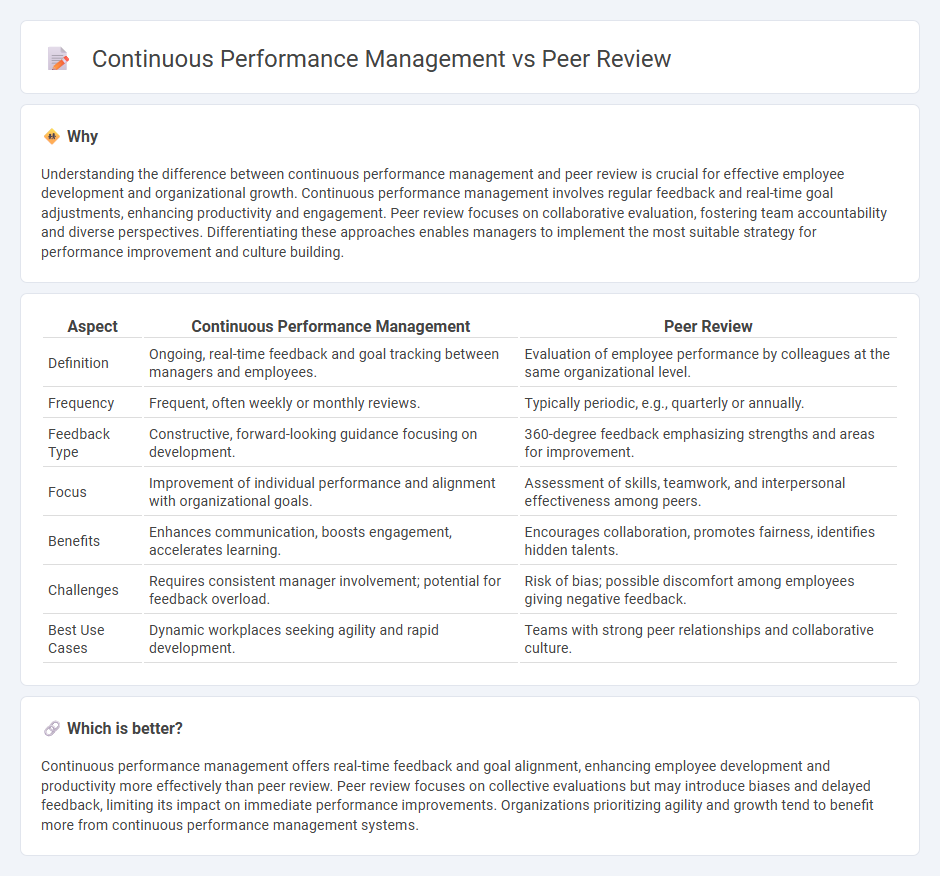
Continuous performance management emphasizes real-time feedback and ongoing development, fostering agility and immediate improvement in employee performance. Peer review enriches this process by incorporating diverse perspectives, promoting collaboration, and enhancing accountability among team members. Explore how integrating continuous performance management with peer review can transform organizational effectiveness.
Why it is important
Understanding the difference between continuous performance management and peer review is crucial for effective employee development and organizational growth. Continuous performance management involves regular feedback and real-time goal adjustments, enhancing productivity and engagement. Peer review focuses on collaborative evaluation, fostering team accountability and diverse perspectives. Differentiating these approaches enables managers to implement the most suitable strategy for performance improvement and culture building.
Comparison Table
| Aspect | Continuous Performance Management | Peer Review |
|---|---|---|
| Definition | Ongoing, real-time feedback and goal tracking between managers and employees. | Evaluation of employee performance by colleagues at the same organizational level. |
| Frequency | Frequent, often weekly or monthly reviews. | Typically periodic, e.g., quarterly or annually. |
| Feedback Type | Constructive, forward-looking guidance focusing on development. | 360-degree feedback emphasizing strengths and areas for improvement. |
| Focus | Improvement of individual performance and alignment with organizational goals. | Assessment of skills, teamwork, and interpersonal effectiveness among peers. |
| Benefits | Enhances communication, boosts engagement, accelerates learning. | Encourages collaboration, promotes fairness, identifies hidden talents. |
| Challenges | Requires consistent manager involvement; potential for feedback overload. | Risk of bias; possible discomfort among employees giving negative feedback. |
| Best Use Cases | Dynamic workplaces seeking agility and rapid development. | Teams with strong peer relationships and collaborative culture. |
Which is better?
Continuous performance management offers real-time feedback and goal alignment, enhancing employee development and productivity more effectively than peer review. Peer review focuses on collective evaluations but may introduce biases and delayed feedback, limiting its impact on immediate performance improvements. Organizations prioritizing agility and growth tend to benefit more from continuous performance management systems.
Connection
Continuous performance management integrates real-time feedback and frequent check-ins, fostering ongoing dialogue that enhances employee development. Peer review complements this by providing diverse perspectives, promoting accountability, and identifying strengths and areas for improvement from colleagues. Together, they create a dynamic and collaborative approach to managing performance and driving organizational success.
Key Terms
Feedback
Peer review emphasizes collaborative feedback from colleagues to enhance individual performance, fostering a culture of shared learning and accountability. Continuous performance management provides ongoing, real-time feedback from managers aimed at aligning employee goals with organizational objectives for sustained growth. Explore more insights on optimizing feedback techniques in modern performance frameworks.
Evaluation
Peer review emphasizes collaborative evaluation by leveraging insights from colleagues to provide a comprehensive assessment of performance, fostering a culture of transparency and mutual growth. Continuous performance management centers on real-time feedback and ongoing assessment, ensuring timely adjustments and goal alignment throughout the evaluation period. Explore more to discover which method best aligns with your organizational goals and employee development strategies.
Goal-setting
Peer review enhances goal-setting by incorporating diverse feedback, fostering accountability, and aligning individual objectives with team outcomes. Continuous performance management emphasizes ongoing goal adjustment through regular check-ins and real-time performance data to maintain relevance and agility. Explore deeper insights into how these approaches optimize goal-setting strategies for sustained organizational success.
Source and External Links
Peer Review in Scientific Publications: Benefits, Critiques, & A New Horizon - Discusses the role of peer review in ensuring high standards in scientific research while highlighting its limitations and potential for bias.
Peer Review - Wikipedia - Explains peer review as a process where work is evaluated by others with similar competencies, often used in academic and scientific contexts.
Understanding Peer Review - Provides an overview of the peer review process, including its purpose and what reviewers look for in a research paper.
 dowidth.com
dowidth.com